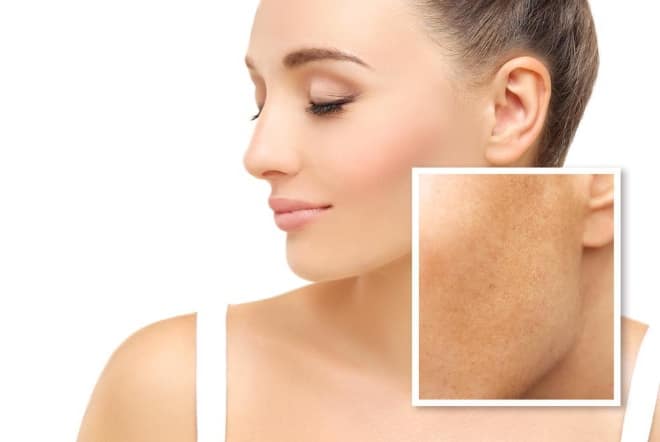Beauty:
Melasma versus hyperpigmentation and how to treat it
Beauty:
22 Oct 2020

It’s funny how hyperpigmentation can creep up on you. One day your skin is clear and radiant then the next you’ve spotted a dark mark. Chances are you’ve tried several beauty counter creams promising to help you lighten up. But, they’re just not working. This is because hyperpigmentation, regardless of how dark the mark is, can be stubborn. Also, if it’s melasma, something that’s often mistaken for hyperpigmentation. But, it’s even trickier to treat! So, let’s help you spot the difference and get you on the right path to a glowing, evenly-toned complexion.
Hyperpigmentation
Your skin is full of melanin, the pigment that gives it it’s colour. It’s created in your melanocytes – little “factories” that sit in the lower layers of your dermis. When these factories go into overdrive, they produce too much melanin. The result is hyperpigmentation. These are dark marks that appear on the surface of your skin. The primary trigger of melanin overdrive is unprotected sun exposure. This is why wearing a high protection sunscreen is a must.
Certain medications, such as antidepressants and antimalarials can also trigger a melanin surge. Same goes for any type of inflammation, be it a pimple or an injury. This is known as post-inflammatory hyperpigmentation. Something those with darker skin tones are especially prone to and familiar with. As with most skin conditions, prevention is always better than cure. However, if it’s too late, there’s a lot you can do about it.
Melasma
Much like hyperpigmentation, melasma is also an overproduction of melanin. What puts it into its own category, however, is its cause – your hormones. As melasma is triggered by oestrogen, 90% of the sufferers are women. When it occurs during pregnancy, it’s referred to as chloasma.
Pregnancy aside, anything else that causes your hormones to fluctuate can trigger melasma. Think – birth control pills or hormonal replacement therapy. Still, just because you’re on the pill or pregnant doesn’t mean your dark marks are definitely melasma. This is why it’s important to have a doctor assess your skin. They can tell the two conditions – hyperpigmentation and melasma – apart just by looking at it. Melasma tends to appear symmetrically. Thus, it would appear on both sides of your forehead, nose, cheeks or chin. To make things even trickier, melasma is also worsened by unprotected sun exposure as well as heat! This means the sauna or even a very hot bath should be off-limits.
So what’s the solution?
Happily, both conditions can be dramatically improved, if not completely banished. They both respond to the same treatments. Melasma, however, is slightly trickier to treat due to its cause. If it’s been triggered by pregnancy, you’ll have to wait for your hormones to level out after your little bundle arrives. If you developed it after taking hormonal contraception, your doctor can help you find a hormone-free solution. With less oestrogen you’re less likely to be scuppered by a continual triggers.
Just a few of the ways you can treat both conditions include applying the right topicals. This always starts with using a high protection factor sunscreen. You should also be using medical-grade brightening skincare. These contain proven pigmentation-inhibiting ingredients such as kojic acid, azelaic acid, niacinamide and glutathione. Navigating the many products out there can be daunting. However, an experienced skincare therapist can assess your skin and suggest an effective routine.
Speaking of an expert…
As we said, medical-grade homecare can make a big difference. But what if you’re dealing with resistant hyperpigmentation or typically stubborn melasma? Then you’ll want to include some in-office solutions too. Again, there’s no ‘one size fits all’ solution. However, a good aesthetic doctor will be able to prescribe a multi-pronged attack.
The most effective in-office solutions include peels and laser treatments. If you’re treating hyperpigmentation, the type of peel you go for will be dependent on the severity of your condition. Melasma, however, is particularly stubborn. So, a slightly more intensive peel, something like a Melanostop Peel, is usually best. It relies on a trusted combination of azelaic acid, resorcinol and phytic acid. These work together to help prevent your melanocytes from going into overdrive while activating tyrosinase, an enzyme that inhibits the production of melanin.
In regards to lasers, a good aesthetic clinic will have several devices for you to choose from. These will include options that are safe and effective for darker skin tones. Fraxel Dual, for example, is just one of them. This has a good track record of clearing both hyperpigmentation and melasma. However, when treating the latter, a highly-skilled therapist will know to use it on a slightly lower setting to avoid it being a heat trigger.
In short, if you seek expert advice, start using the right products and embark on a series of in-office treatments, both hyperpigmentation and melasma can be a thing of your past.

Comments
Nonkululeko
Hi I have hormonal imbalance, when I’m on my circle I break out. I really want to control that and also recover my Skin to glowing even tone glass face. Thank you